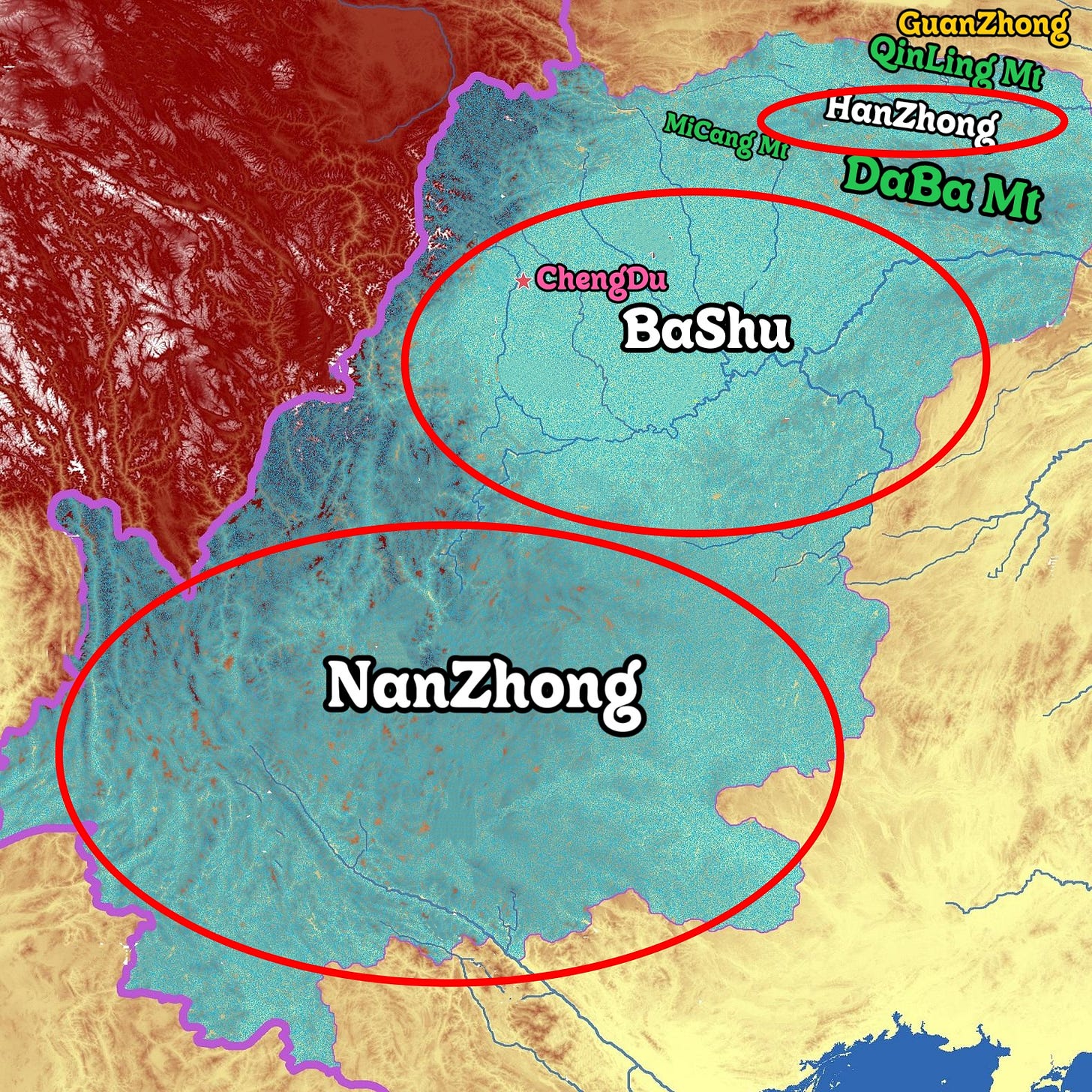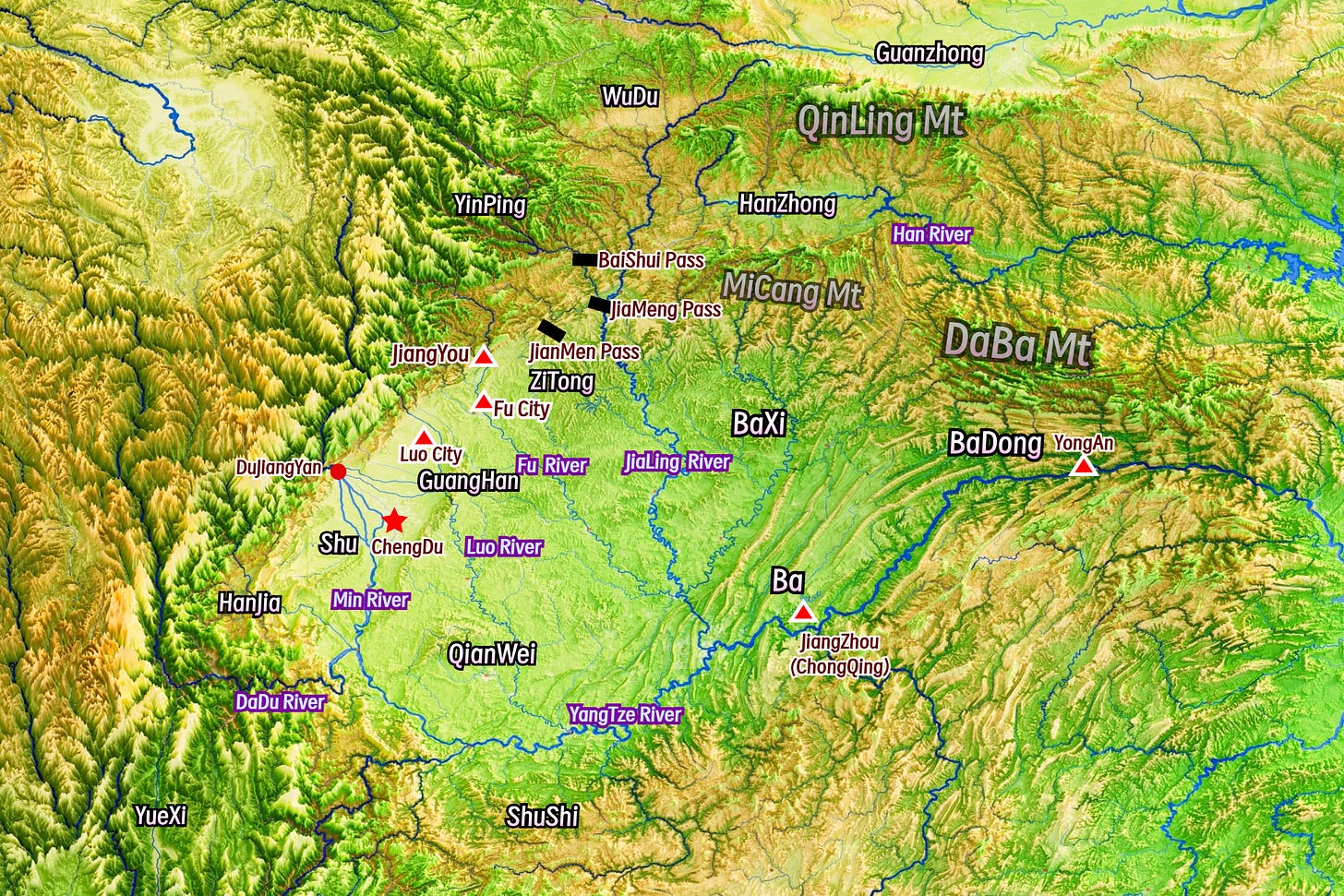Province of Yizhou(Introduction to Three Kingdoms Administrative Region Names 12)
Important Places of Three Kingdoms
Catalog of Three Kingdoms history
More Place Name of Three Kingdoms
Yizhou益州 was the largest province in terms of area during the Eastern Han Dynasty(25-220AD). Located in the southwestern China, Yizhou was basically equivalent to the entire territory of Shu Han(221-263AD) during the Three Kingdoms period(220-280AD). It included most of the present-day provinces of Sichuan四川 (the core region), Yunnan云南 & Guizhou贵州 (the Nanzhong南中 region), as well as small parts of Shaanxi陕西 (Hanzhong汉中), Hubei湖北 (Shangyong上庸), and Gansu甘肃 ( Yinping阴平).
Yizhou can be geographically divided into three core regions, namely Hanzhong汉中, BaShu巴蜀, and Nanzhong南中.
Hanzhong Commandery, located in the basin and valley area between the Qinling Mountains秦岭 and the Daba Mountains大巴山, it is the necessary route connecting Yizhou and Guanzhong关中, and is known as the throat of Yizhou.
The origin of the Han River汉水 is in Hanzhong, and Hanzhong is also named after the Han River. During the Eastern Han Dynasty, besides the Hanzhong Basin, Hanzhong commandery also included the vast Qin-Ba valleys between the Qinling Mountains and the Daba Mountains along the Han River to its east. At the late Eastern Han period, Xicheng西城, Shangyong上庸 and Fangling房陵 were set separate to form three new commanderies, collectively known as the “Three Eastern Commanderies”, which came under the jurisdiction of Jingzhou荆州 Province.
Hanzhong was surrounded by mountains, and the passages into Hanzhong were the Chencang陈仓 Road, Baoxie褒斜 Path, Tangluo倘骆 Path, and Ziwu子午 path in the north, the Han River waterway in the east, and the Jinniu金牛 Road and Micang米仓 Path in the south.
But except for the Chencang and the Jinniu Roads, which eventually entered Hanzhong via the Yangping Pass阳平关 in the west, the rest of the paths were either mountainous and treacherous or the rivers had too great a drop, and all of them required building plank roads to pass through, which only required a small number of soldiers to be stationed or a fire to be set to block the enemy.
Therefore, Hanzhong Commandery is the throat of the whole Yizhou, and Yangping Pass is the most crucial “security door” in Hanzhong.
The most central region of Yizhou, BaShu巴蜀, is the Sichuan四川 Basin and its surrounding areas. The region was named after the ancient States of Shu(? - 316BC) and Ba(? - 316BC) during the Zhou Dynasty(1100-256BC), and comprised mainly present-day Sichuan Province as well as most of Chongqing重庆.
It was the territory of Yizhou under the rule of Liu Yan-Liu Zhang(刘焉-刘璋), father and son, which included Commanderies as Shu蜀, Ba巴, Guanghan广汉, Qianwei犍为, the Dependent State of Shu蜀郡属国(later changed to Hanjia汉嘉 Commandery), and the dependent state of Guanghan广汉属国 (later changed to Yinping阴平 Commandery).
Shu蜀 Commandery, named after the Ancient State of Shu古蜀国, is an area in the western part of present-day Sichuan Province centred on Chengdu成都. It was established by the State of Qin秦国(905BC-221BC) after it destroyed the Ancient state of Shu during the Warring States period(476-221BC). During Liu Yan's reign as Provincial Governor of Yizhou, he moved the seat of Yizhou to Chengdu in Shu Commandery, which became not only the centre of Yizhou, but also the capital of the Shu Han Empire(221-263AD), as well as a number of later ruling regimes in Sichuan.
The famous water conservancy project Dujiangyan都江堰 was built under the leadership of Li Bing李冰, the then governor of Shu Commandery in the Qin State. During the Shu Han period, Liu Bei's most trusted strategist Fa Zheng法正, the representative of the local forces in Yizhou, Yang Hong杨洪, and the general Zhang Yi张翼 in the later period, all had served as the governor of Shu Commandery .
Guanghan Commandery, located in the vast area between Shu Commandery and Hanzhong. The original seat of Yizhou, the Luo City雒城, was located in Guanghan Commandery.
After Liu Bei captured Yizhou, he set aside the mountains in the northern part of Guanghan Commandery near Hanzhong and created a new Zitong梓潼 Commandery, where the famous passes in Yizhou, Jianmen Pass剑门关, Jiameng Pass葭萌关 and Baishui Pass白水关, were all located here.
Ba Commandery巴郡 was named after the Ancient State of Ba, which was also established after Qin's destruction of the state of Ba. Ba Commandery included the eastern part of present-day Sichuan Province and the city of Chongqing, and ‘Ba’ gradually became the short name for this area. After Liu Zhang became the governor of Yizhou, he divided Ba Commandery into three Commanderies, namely Ba , Badong巴东 , and Baxi 巴西, and since then the area has been called "Three Ba s"(三巴).
The city of White Emperor, also known as Yong'an永安, where Liu Bei died and entrusted his Empire and son to Zhuge Liang, was located in Badong Commandery, which was the eastern gate of Shu Han facing Wu. In 264 AD, after the fall of Shu Han, Eastern Wu(221-280AD), who wanted to take the opportunity to grab some territory, launched an army of 30,000 to attack Yong'an. Luo Xian罗宪, the last famous general of Shu Han, led only 2,000 men to defend this city for 6 months, and finally held out until Sima Zhao司马昭 sent reinforcements.
In contrast to “Three Ba s”, the three Commanderies of QianWei犍为, Shu and Guanghan were known as “Three Shu s”三蜀. QianWei Commandery was to the south of Shu Commandery , and included the present-day cities of Leshan乐山, Yibin宜宾, and Janyang简阳 in Sichuan Province, whose territory was an important route connecting the BaShu region with the Nanzhong region.
The present-day Ya'an雅安 and Lushan芦山, west of Chengdu, were previously called the Dependent State of Shu Commandery蜀郡属国 , it served to administer and resettle the local barbarian tribes, which Liu Bei renamed Hanjia汉嘉 Commandery after the founding of the Shu Han Dynasty in 221 AD.
To the northwest of Guanghan Commandery, there was likewise an area where local minorities were settled, called the Dependent State of Guanghan广汉属国 . After the establishment of Shu Han, the Commandery was renamed Yinping阴平. It was from here that Deng Ai邓艾 crossed hundreds of miles of mountain trails to reach the Chengdu plain in 263 AD, and the defenceless Shu Han regime was declared dead after a little resistance.
Nanzhong南中 refers to the area to the south of the Dadu River大渡河 in present-day Yunnan云南 and Guizhou贵州. There were initially five Comanderies in Nanzhong, namely the Dependent State of Qianwei犍为属国(ShuShi朱提), Yuexi越巂, Yizhou益州, ZangKe牂牁, and Yongchang永昌.
After Liu Bei occupied Yizhou, he first renamed the Denpendent State of Qianwei as Shushi朱提 Commandery, but as Hanzhong in the north and Jingzhou in the east were facing fierce battles, he had no time to take care of the Nanzhong region.
The region was home to numerous ethnic minorities from the southwest and many local Han Chinese magnates, who had long disobeyed the central government and were semi-independent. Although the land area was extremely vast, it could hardly bring help to the economy and military of Yizhou.
It was only after the loss of Jingzhou in 219 A.D. that the Shu-Han regime began to gradually strengthen the management of Nanzhong, and Liu Bei set up the Regional Commander of LaiXiang庲降都督, appointed with Deng Fang邓芳, to oversee the military and political affairs of Nanzhong.
After Liu Bei's death in 223 A.D., another rebellion broke out in Nanzhong until 225 A.D., when Zhuge Liang personally led an army to quell the rebellion in Nanzhong. In order to strengthen the administration, the Yizhou Commandery was renamed as Jianning建宁 Commandery, and a new Xinggu兴古 Commandery was set up by carving out a part of land from Jianning and ZangKe, and a new Yunnan云南 Commandery was set up by carving out a part of land from between Jianning and Yuexi .
During the reign of Shu Han, there were long set the Regional Commanders of LaiXiang to manage Nanzhong, most of them were Yizhou natives. Li Hui李恢, from a large local family in Yizhou, Zhang Yi张翼 and Ma Zhong马忠, famous local generals in Yizhou, all had served in that position. Although the Shu Han regime tightened its control over Nanzhong, there were still frequent rebellions in the economically backward and fiercely popular Nanzhong region.
To be Continued.
Your support is my greatest motivation!







